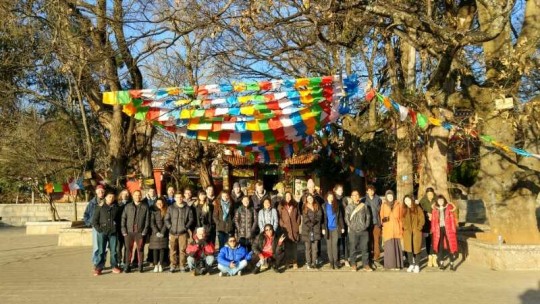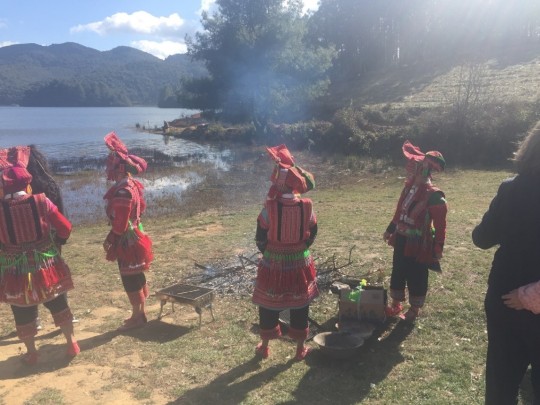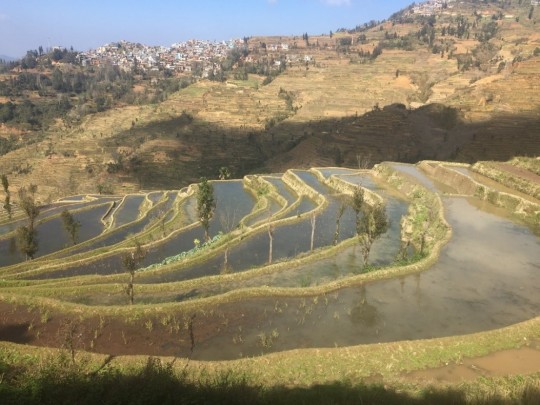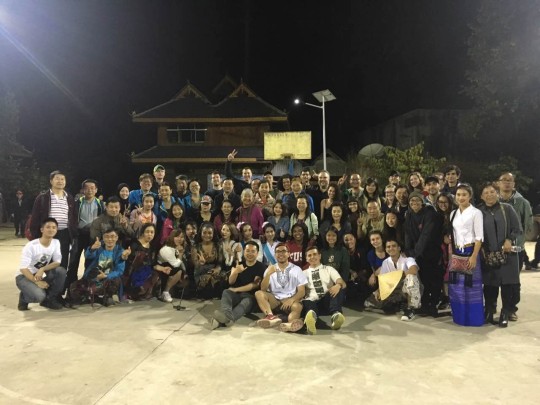#livelearngrowabroad
Text
Weekend in Cusco
This past week, we all traveled an hour and a half from our station in Urubamba to Cusco. Although not the capital of Peru, Cusco is an amazing city known for its food, culture, and Inca influence. The entire base of the city was built by the Inca people before the Spanish conquered the area. The oldest streets are still lined with walls and architecture that are thousands of years old. We spent the first day exploring the Plaza de Armas and the artisanal markets selling traditional sweaters, ponchos, and sandals.

The following day was spent in the outskirts of Cusco hiking and horseback riding! We got to see the city from above as well as tour the Inca moon temple. We learned about the rituals and ceremonies that the ancestors of the Inca still perform at this temple during the full moon. There is still a very strong indigenous influence in this area and those descendants- the Quechua people- are very proud of their heritage.

The most exciting part of our time in Cusco was an excursion to Rainbow Mountain. Only opened last year to tourists and visitors, this mountain is a geologist’s dream. The area is striped with many vibrant colors- the results of the high levels of minerals in the soil. It also gives an awesome view of Ausangate- the 3rd tallest mountain in Peru at over 20,000 feet- from the top. Between a 4:15 wakeup call, having to walk 16 kilometers, and being at 15,000 feet, the hike up was exhausting. We struggled to the top and were rewarded with some of the best views of the semester thus far. We were instantly rejuvenated by the amazing views as well as the snow blowing over from the surrounding mountains.

This trip wraps up the section of our program in the Sacred Valley. In less than a week we will be leaving for maybe the most exciting part of the SFS Peru program- the Amazon! We are also beginning our fifth class of the semester, Directed Research. This class takes up the entire last month of the program as we design our own research project, collect and analyze data, and present the data found. I am so excited to get down to the jungle and do research in the most biodiverse area in the world!

#fairfieldabroad#studyabroadfairfield#fairfielduniversity#travel#explore#livelearngrowabroad#wanderlust#peru#SchoolForFieldStudies
0 notes
Text
Yunnan Province & Chinese New Year - Aliyah (’18)
As my winter break came to a sudden halt, I waited and watched as the newest group of TBC students arrived on campus. I was excited and nervous to meet the incoming class of spring semester 2017 students. Although I had already been in Beijing for the past 6 months and felt extremely comfortable with the language, culture, surroundings and my own daily routine, I began to feel like a newbie again. Fresh off the 15 hour flight from America, were 27 new faces that I had never met before. It was a strangely paradoxical feeling to have the confidence of a veteran student and the awkward butterflies of a Beijing newcomer. Nonetheless, we all slowly began to get to know each other throughout our five day orientation, which actually felt like two weeks. During orientation we were given a general layout of the semester and of course our semester excursion to Yunnan. Yunnan (云南省) is a province in Southern China. We were all very excited to explore a part of China opposite Beijing and its frigid winter weather. We left for Yunnan on January 22 and returned on February 2. After just a four hour flight, we arrived in a tropics-like paradise. Light, warm air filled our lungs and brightened our smiles. We were so excited to remove our thick coats and some of our now unnecessary layers.

TBC Spring 2017
When traveling to every destination, we always split into two smaller groups, which we called Bus A and Bus B. We arrived in Yunnan province’s capital, Kunming (昆明); a beautiful tourist city with many hills, lakes, and of course tons of people. Yunnan is home to 25 of China’s 56 ethnic minorities, therefore we were able to encounter some of the many distinct cultures that make China such a beautifully diverse country. Unfortunately as we were limited with time, we only got to experience five ethnic minority cultures in person. Among these were the Yi, Hani, Dai, Naxi, and Bai Peoples.
In the Yi village we were greeted by some of the village women in their traditional, hand sewn dress. They also performed a “dragon dance” and treated us to some welcoming shots of baijiu 白酒 (rice wine liquor). Later we were further separated into groups of 5-6 people to be assigned to a homestay and a homestay mother. We relinquished ourselves of our heavy luggage and loaded into the back of a medium sized truck, in order to make our way up the mountainous hillside and dirt roads to the have dinner shore side of the infamous Yangtze River. There, we took pictures, played games and learned another traditional dance called the bug dance. We had dinner on the grass beside the river which was cooked outside over a rustic wooden flame.

Yi Women in traditional dress as they prepare dinner
In the Hani Village, we were again greeted by the village women dressed in Hani style traditional dress. They sang us a song in the Hani language and offered us a pulpy citrus drink in tiny, hand carved wooden cups. We were escorted to a village house for lunch. Several dishes adorned each table, and we were ready to dig in. We ate and chatted amongst each other and some village children while also listening to the village women sing and dance in circles. After lunch, we were escorted by a few young village children on a hike up through the village and along the handmade rice terraces. These rice terraces were unlike anything I had ever seen. The terraces carried on for miles, extending to the highest mountain and throughout the widest part of the area. The hike was fun yet challenging. It was as if we were a playing a game of who will fall into the rice terraces first. Despite our tiny fears, we reached our destination. The views were magical and the air was so fresh and crisp.

Rice Terraces in Hani Village
On our way to the Dai Village, we stopped in city called Jinhong (金红) where we celebrated Chinese New Year. Chinese New Year is the most celebrated holiday in China. All companies, schools, and most restaurants close at least two weeks before Chinese New Year. This is because most people travel back to their home provinces in order to celebrate the New Year with their families. Even though in China the calendar year is now based off the Gregorian calendar, as in the West, Chinese people still recognize many aspects of their traditional lunar calendar, which is why Chinese New Year is never on the first of January. The Chinese even have separate zodiac signs based on one’s lunar calendar birthday. There are 12 animals that are included in the Chinese zodiac. As the clock clicked down, fireworks went off throughout the city and continued for almost two weeks after the New Year. It’s safe to safe that Chinese people love fireworks as a celebratory gadget.

Yunnan Gadgets
Now, at the Dai Village the weather was just shy of 80 degrees. Unlike the other two villages we had previously visited, the Dai village was very touristy and had tons of visitors. We explored the streets, purchasing and trying on customary attire and ancient Chinese knickknacks. Once the village “closed” the crowds disappeared, and we were allowed to stay as overnight guests. Before bed, we attended a performance on the basketball court lit by street lamps. Dai villagers, other visitors, and of course all the Tbc students and staff, spent the night enjoying each other’s company and sharing and embracing one another’s culture. Before the night ended, we performed the cupid shuffle, the “whip & nae nae” and a poorly executed soul train line.

TBC Students with Dai Villagers and other tourists
Then we made our way to a city called Lijiang (丽江) where the Naxi Village was. Here we had a social dinner, and explored the village streets. There were animals roaming every street and around every corner. As in the last village, after dinner there were more performances. The Naxi people sang in Chinese, English and Dongba, their native language. Two men even performed a fire dance which was insane to watch. They rubbed fire on their skin, clothes, hair, and even put flaming sticks down their pants for a few laughs. Four other TBC students and I sang the infamous “Aint No Mountain High Enough”. Lastly, four other TBC students from Columbia rapped a reggaetone song and then even performed a Columbian dance called choque to the fast paced beat.

TBC students with Naxi woman
Our final village was that of the Bai people. The Bai people are Muslim. It was cool to see how their Islamic practices and Chinese culture combined so gracefully. I liked this because it shows how many different kinds of people there are in the world. In the U.S, Islam is solely associated with Middle Eastern peoples, even though it is such a wide spread religion, touching all continents across the globe. They prepared us lunch, which was a combination of Southern Chinese cooking with a clear Islamic influence. Then we explored the village and made our way to the village mosque. This mosque was different than some of the mosques I saw in Xinjiang Province. This mosque had less of a Middle Eastern architectural influence and remained mostly Chinese in architecture and overall structure. Afterwards, some friends and I, accompanied by an older Chinese man, climbed the bell tower and he helped us ring the bell which could be heard throughout the village.

View of Bai Village from Mosque Bell Tower
Finally, we made our way home as we completed our 12 day itinerary with a return flight back to Beijing. After just 12 days, the same group which had previously been total strangers to each other were all hanging out and chatting together as if we had all been friends for years. #FriendshipsHappenInChina

“Bus B”
#fairfieldabroad#studyabroadchina#thebeijingcenter#explorechina#studyabroad#livelearngrowabroad#wanderlust
0 notes
Text
Hola Amigos! - Caroline (’18)

Classes are in full swing and life is very busy here at the station. I’ve settled in to Urubamba and it already feels like home- I feel like I have been here for months! Urubamba is in the middle of the Sacred Valley so we are close to lots of ruins and indigenous populations as well as bigger cities like Cusco.
I share a room with two other girls- Leigh is from Hamilton College and Isabelle is from Reed College. One of my favorite things about this program is how close everyone gets in such a short amount of time. There are only 19 of us in the program (which is actually the biggest SFS Peru group ever!) so we eat meals together, go to class together, and travel together. After classes we go on hikes, play volleyball, or have bonfires- we joke that this program sometimes feels like summer camp. As much as I love and miss my Fairfield friends, its awesome that this program has given me the opportunity to branch out and meet all new people who are also interested in conservation, environmental science, and field research.

Me and my roommates at the ruins of Pisac.
Speaking of field research, the best part of the program for me is the emphasis on field lectures and labs. We spend hours every day- if not the entire day- outside. For example, last weekend we traveled to Mantanay- a huge area of conservation land in the Andes- and spent the day identifying Peruvian birds and hiking for our conservation science class. A few days later we went to a traditional agricultural market and interviewed the locals about their production and harvesting methods for our political ecology class. All five of our courses are field based, I really like that this program allows us to learn by doing our own research in the field instead of simply reading what others have done.

Class at 13,000 feet in Mantanay.
There is no typical day in this program, which definitely keeps me on my toes. Some days we have lectures and discussions at the station while other days are spent hiking and doing field labs. As the semester progresses we will also have a lot of overnights to different areas of Peru. In the next week we will be traveling to Quillabamba to explore agricultural markets and then Espinar to research the environmental impacts of mining.
The last few weeks have been overwhelming yet exciting. Even though it is a huge change from my life at Fairfield, I have already learned and experienced so much from living in Peru.
#fairfieldabroad#studyabroad#studyabroadperu#TheSchoolForFieldStudies#travel#explore#livelearngrowabroad#wanderlust
0 notes